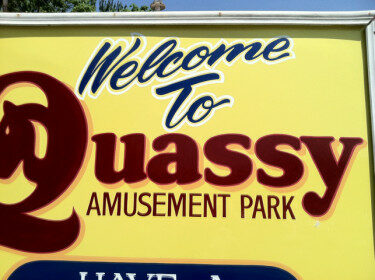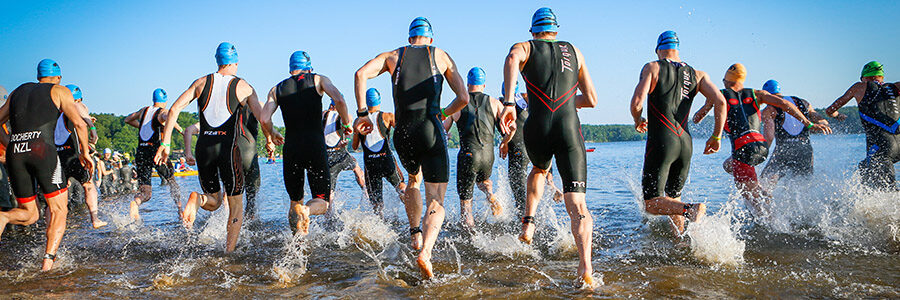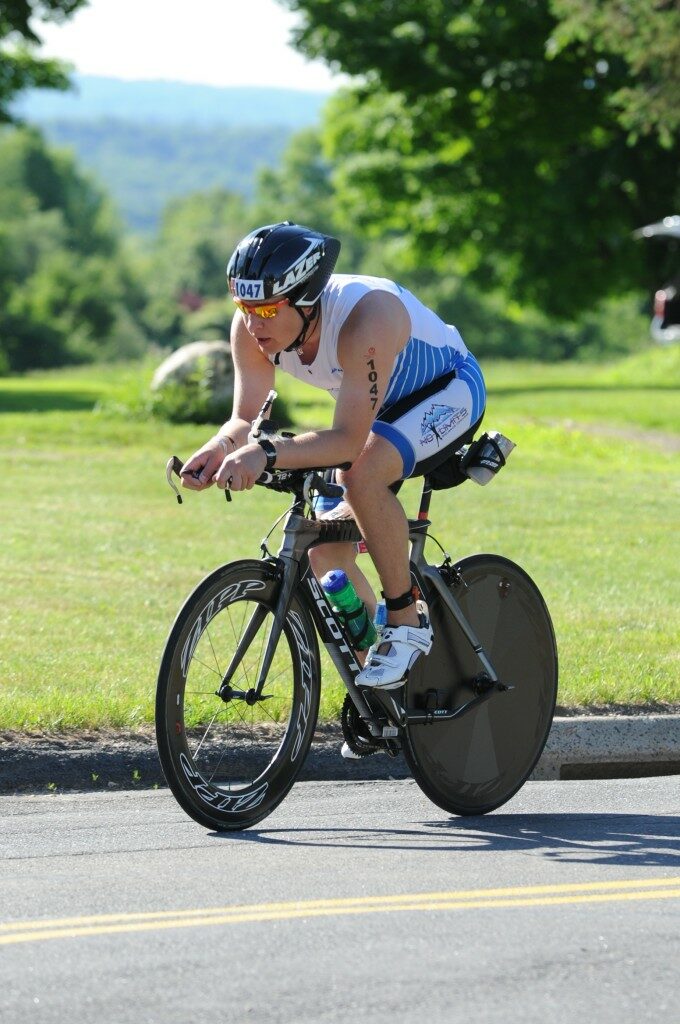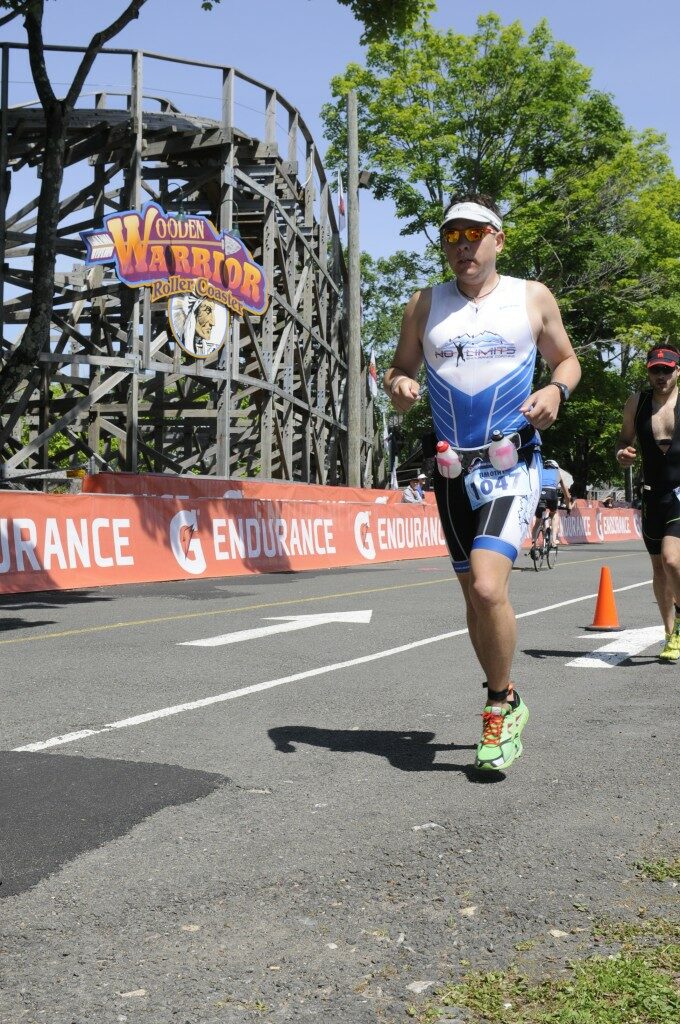[The following race report is from No Limits athlete Tim Byrne, who raced Challenge Quassy on June 7, 2015.]
 To be completely honest: I was not excited to race this one.
To be completely honest: I was not excited to race this one.
At all.
Three weeks prior to Challenge Quassy, I had raced at the Raystown half-distance triathlon, and had a painful and challenging run. While post-race reflections helped me understand what had happened and how I can work through challenges, I still wasn’t ecstatic at the thought of similar experience.
I wasn’t nervous, I just didn’t want to explode again. [Note from the coach: Tim absolutely did NOT explode at Raystown. It was a hard race, and he won his age group! How many of us would like to “explode” like that?]
I didn’t let the thought of Raystown effect me mentally to the point where it would affect my performance, but I just did not feel my usual pre-race excitement. I felt this way until, literally, halfway through the bike, when I realized how gorgeous of a day it was and how lucky I was to be there and how big of a baby I was being.
I am LUCKY to do this.
Swim

As my wave waited for the start, we naturally formed 3 lines prior to the beach start: 1) one group right on the water, 2) one group just back from the water, and 3) ‘stragglers’ in the back on the beach. I chose group 2.
I ran in until the water was about waist deep. There were too many people in front of me to dolphin dive so I just awkwardly jogged until I started swimming.
The first straight away (of the triangle-shaped course) was surprisingly rough. I was bumped by a few zig-zaggers. I definitely kicked someone in the face who kept laying on my calves.
Given the fact that I had swam once in the 3 weeks since raystown, I realized this was going to be a brutally painful swim, with a high RPE and a slower-than-optimal time. My main goal was to not blow myself up – the main reason for this race was a hilly training day for Ironman Lake Placid, not to destroy my swim PR.
I felt good for the first 2 straights, although it was apparent I was slowing down as the field I was originally with had pulled ahead of me a few meters.
I started conservatively which was a great call because by the end of the swim, I was pretty exhausted and slowed down anyway. I was able to get on a few feet throughout the race, but once the effort to keep with them became unsustainable, I had to let them go.
Between the first turn and the second, the glare during the swim is brutal. I have dark tinted polarized goggles which helped a lot, but it was still tough to see. I definitely couldn’t see the turn buoy, so I had to follow the individual smaller red buoys, which sucked because it was a slightly longer swim (the buoys were parabolic, not a straight line).
Despite not coming into this race in the best of swim shape (due to work and life getting in my way), I exited the water in 32 minutes. I was pleasantly surprised – even though it was a pretty painful for just a steady effort.
Lesson learned: when life throws curveballs, try to stick with consistency as best you can or you’ll pay for it on race day.
Bike

My main goal for the bike was to have my normalized power within the range Maria had given me. I succeeded. The only drawback is I noticed myself spiking on especially steep hills.
There was one hill I remember where it was ABSOLUTELY NECESSARY for me to blow my climbing cap in order to stay upright & balanced, whereas during Raystown it was necessary to blow that cap several times. Quassy had more gradual/longer climbs, whereas Raystown had tons of short steep cliffs.
Since I was in the first wave, I was pretty consistently passed the whole time – especially once the 30-39 age groups caught up to us. It is frustrating, but I concluded that:
- it’s better to be passed than to have to weave around everyone (I tried to be as considerate as I could on the course; I feel their pain after the Philly and New York City triathlons last year. Ugh.) and…
- if these guys made up the start time deficit and are passing me this early on the bike course – they are good triathletes. They can expend more energy on hills than I can.
The Quassy bike course elevation chart shows a seemingly large hill at mile 23, and I had built it up so much in my visualizations prior to the race. But, when I got to it, it really didn’t seem as bad as my expectations. It was long, but it was not very steep.
I also gained confidence in my controlled approach to climbing when I noticed that a man in front of me kept getting up out of the saddle to hammer it. Yet, he wouldn’t pull away from me that much. He wasn’t getting his ‘bang for the buck’ with the energy he was expending. I stayed in control and was able to keep just with him and power over and down the hill.
In sum, the bike course is really gorgeous, and was a great tune-up for Ironman Lake Placid. A few of the roads were pretty sketchy though – pot holes, bad patching etc.
Run

As I came out of T2, Raystown was still fresh in my mind. But I had lessons from there that Quassy was perfect for practicing. Namely:
- drink more on bike
- don’t go out of transition too fast
- walk hills if necessary
It was go time. In my mind, the run was the real race. I could not explode at two half distances in a row and expect achieve my goals at Lake Placid.
A few seconds out of transition (before I even got out of the parking lot) I checked my watch and I was running too hard.
No good.
I immediately slowed down to a more controlled number, as Maria and I discussed when putting together my race plan.
Turning left out of the parking lot was a huge f@#$%&*^g hill. It was not steep but it was very long.
I instantly started cursing under my breath, but I realized my HR was somehow still in Z2. Weird – I assumed it just hadn’t caught up with the effort yet.
At the top of the hill you make the left onto the road around the lake (which turns to gravel a few miles later) and run by houses. The crowds were great on this section – it was reminiscent of the Ocean Drive Marathon in that they were sparse, but the people who were there were awesome.
They had aid stations approximately every mile. Throughout the run I had the following aid station protocol:
- grab 1 gatorade, chug it
- grab 2 waters
- drink half of first, pour other half over head
- pour 2nd over head
- grab ice
- pour into shirt
Since I wear a hydration belt, a dam was formed around my waist, so when I would pour ice into my top it would all pool around my stomach. It was amazing.
After the road turns to gravel, the hills start to pick up. I would run until mid Z3, then walk until the crest (or until the grade decreased, then I would run until mid Z3 again).
With the hill strategy, I was conservative with mid Z3. Partially because I was surprised I was running pretty hard and still in Z2, and partially because I would rather finish a few minutes later than blow up again.
After the gravel road, the course makes a left onto the bike course, which leads to a left turn back to the park. Literally .25 miles from the finish you are taken left into what I called ‘the depths of hell’ – the especially hilly part that goes through a neighborhood (approx. the last 6 miles).
Immediately after the left, you spend the next .4-.5 miles descending down a particularly steep hill, which you know you have to run back up right before you finish. That thought was in the back of my mind the entire time back there.
So, I kept to my strategy at the aid stations and with approach the hills. For the first time in my triathlon career I think I passed more people than I was passed by on the run.
It felt good.
The whole run was as if I had not done the bike before hand, and I was just running on a ‘good’ day. I had only started to feel those feelings in April when my long runs were really starting to come together – so I had never experienced them in a race. It was pretty excellent.
Walking as necessary didn’t effect me mentally. I knew I was on track for a sub 2-hour run as long as I could capitalize on the downhills and the flats (which I did).
The final hill going up was brutal, but not as much as I thought it would be. As with the mile 23 hill on the bike, my expectations were worse than the reality.
There was a huge crowd of people there, obviously knowing it was the final push before the finish, and I was not about to start walking in front of them (even though I had budgeted a few minutes for a walk up that hill during my mental math sessions).
I wish I could buy all the people on that hill a beer, because they were flipping awesome.
After the hill you could hear the announcer and see the turn off to the finish area. I opened it up as much as I could (until the very end – the guy in front of me ran through the finish with his kids and I didn’t want to trample them). And I brought it in – with a personal best half marathon time, and a solid race overall.
My Conclusions
Maria was right:
- about fitness cycles. I hadn’t felt on my a-game right after Raystown, but Maria said my fitness would cycle back. It did.
- about my swim fitness being there despite having to miss quite a few sessions, even if it wasn’t as “sharp”.
- about the amount of water I needed on the bike.
- about my run fitness being there, even if it wasn’t showing in all of my run workouts after Raystown.
Takeaways
- GET IN THE POOL. Find a way even while traveling. I can do 2.4, but it doesn’t have to be that painful. And it can be faster.
- All those trainer rides in March and April, between bonking and feeling sick from overeating, resulted in a pretty excellent/reliable nutrition schedule come race day.
- Continue to drink way more on the bike
- Use ice – ice is my current best friend next to power meter, endurox, and Nuun
